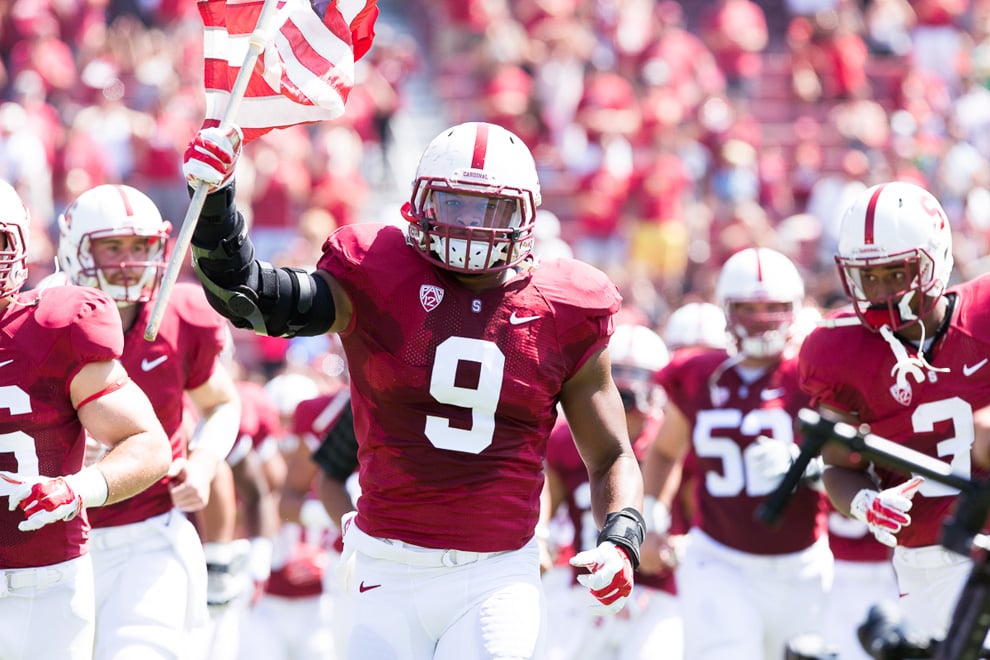Reflecting on the Cardinal’s 8-5 season and the recent news of Andrus Peat’s and Alex Carter’s early declarations for the 2015 NFL Draft, we asked football writers Joseph Beyda, George Chen and David Cohn: What were the biggest takeaways from the 2014 Cardinal football team and how does the team look heading into 2015?
Joseph Beyda: As the 2014 season rolled on, it felt like each week brought another dose of inexplicable for Cardinal football. Ten points on five red zone trips against USC? Check. Another gut-wrenching defeat in South Bend? Check. A no-show loss against an ASU team that Stanford dominated twice in 2013? Check. Three near-perfect games — including a top-10 win — to cap Stanford’s worst season in half a decade? Check, check and check.
Looking back, though, the 2014 Stanford football team is simple to explain. The Cardinal defense managed to execute week in and week out; the Cardinal offense didn’t.
I’m sure David Shaw is tired of saying that word, “execute.” The keys on my laptop that spell it out have become worn down this season. I think George captured the lesson of Stanford’s Jekyll-and-Hyde offense best in his column yesterday: The Cardinal can’t afford to play below their potential if they want to succeed.
So what does that mean heading into 2015?
Well, other than Andrus Peat, Lee Ward and potentially Kevin Hogan, Stanford returns the same exact offense that dominated Cal, UCLA and Maryland. The Cardinal need that unit to play like it’s a year older — to move past the chop blocks, the fumbles and the staring-down-of-receivers — as it began to in its last three games. Stanford also needs Lance Anderson’s well-oiled machine — the defense and its veteran coaching staff — to crank out this year’s set of replacement backfield partiers, just as it did to everyone’s surprise last season.
If those two things happen this offseason, we’ll look back on 2014 as a maturing year for Cardinal football’s next push to the top. That’s not the end of the world. But if they don’t, we’ll look back on 2014 as the year Stanford lost its foothold among college football’s top programs.
The pressure’s on.
George Chen: As I outlined in my column yesterday, I’m worried about the direction that Stanford football is trending towards. What we missed the most this year was the blue-chip mentality that’s come to be associated with the Cardinal the last five years. Without a clear-cut leader on offense, no one rallied the troops when the offense disappeared. And with veterans like Jordan Richards, David Parry and Henry Anderson departing, the question of who will step in to fill the void on defense is a legitimate one.
I do think the fan base needs to temper down their expectations a bit, especially with how deep the Pac-12 is right now. Oregon will always be Oregon, USC is rising with all of their scholarships back and UCLA may be pretenders on the national stage but they’re still tough to beat with Jim Mora at the helm. I’m not saying that Stanford won’t win another Pac-12 championship within the next five years, but that should not be the expectation. Like Joey said, poor execution was a big reason for why the offense struggled this year, but you also can’t overlook the inexperience on the offensive line and the lack of a workhorse running back.
David Cohn: I completely agree with Shaw’s assessment of this 2014 season, as this season was a lesson in how small the margins can be in college football. The Card lost to USC, Utah, and Notre Dame by three points, which ultimately means a mere four points is the margin between a possible 10-2 record, and the Card’s actual 8-5 mark.
If Stanford wants to re-establish its position among the top teams in the conference, it will need to establish more consistency on offense, particularly against the elite teams in the conference. This means that Kevin Hogan, or, if he decides to leave, his successor under center, needs to maintain a certain level of consistency at the position. This does not mean that Hogan has to shred every defense like he shredded Cal, UCLA and Maryland’s defense, but he has to avoid the performances he turned in against Notre Dame and Utah, because as we saw this year, the offense will go as Kevin Hogan goes.
Secondly, the defense will have to remain an elite unit for the Cardinal to be competitive in 2015. While it will be very difficult to replicate this year’s standout performance, talented young contributors such as Peter Kalambayi and Harrison Phillips will have the opportunity to build on this season alongside experienced and outstanding veterans such as Blake Martinez and Kevin Anderson.
Ultimately, especially on defense, next season will present the challenge that each new season brings, namely challenging the Card’s ability to reload through the “Next Man Up” philosophy.
Contact Joseph Beyda, George Chen and David Cohn at jbeyda ‘at’ stanford.edu, gchen15 ‘at’ stanford.edu and dmcohn ‘at’ stanford.edu.
